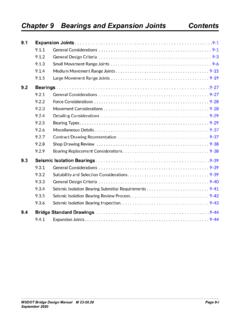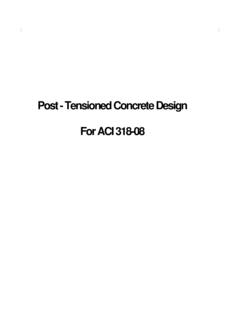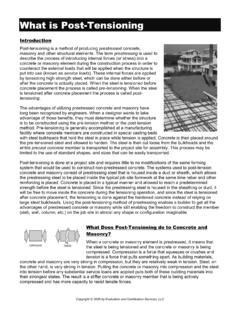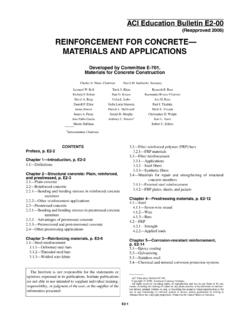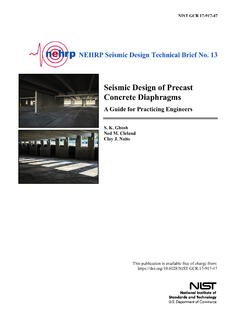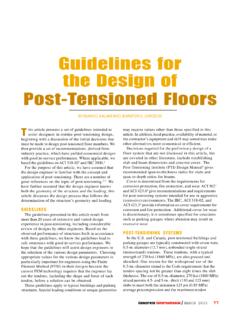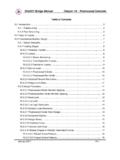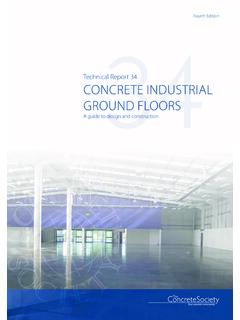Transcription of SECTION 1 INTRODUCTION TO POST TENSIONED CONCRETE
1 SECTION 1 INTRODUCTION TO POST TENSIONED CONCRETEDEVELOPED BY THE PTI EDC-130 EDUCATION COMMITTEE NOTE: MOMENT DIAGRAM CONVENTION In PT design, it is preferable to draw moment diagrams to the tensile face of the CONCRETE SECTION . The tensile face indicates what portion of the beam requires reinforcing for strength. When moment is drawn on the tension side, the diagram matches the general drape of the tendons. The tendons change their vertical location in the beam to follow the tensile moment diagram. Strands are at the top of the beam over the support and near the bottom at mid span. For convenience, the following slides contain moment diagrams drawn on both the tensile and compressive face, denoted by (T) and (C), in the lower left hand corner. Please delete the slides to suit the presenter's convention. REVIEW: FUNDAMENTALS OF PRESTRESSED CONCRETENEW: DIFFERENCES BETWEEN PRE TENSIONING AND POST TENSIONINGREVIEW OF REINFORCED CONCRETEC ritical Point for CrackingStages of BehaviorUncracked Cracked (~Elastic) Ultimate REVIEW OF REINFORCED CONCRETEMcrMyMnMomentCurvatureLarge deflections due to crackingSteel is not engaged until after crackingREVIEW OF REINFORCED CONCRETER einforcement is PASSIVES teel crosses cracks, but does not prevent themQUESTION TO PONDERS uppose a R/C beam has too much cracking and too much deflection.
2 How might you propose to fix it? ( not replace it)Tension (bending) + Compression ( squeezing ) = Net Zero Stress Sqeezed Before Loading (Pre-compressed):Pre-Compression ( prestressing ) + Tension (bending) = Net Zero StressHOW TO BUILD IT? Prestressing: CONCRETE pre compressed before loading in bending (flexural tension)1. Pre-Tensioning: Steel TENSIONED beforeconcrete is placed2. Post-Tensioning: Steel TENSIONED afterconcrete is hardenedPrestressing is ACTIVE can prevent cracks from formingPRE TENSIONING1. Tension Strands2. Cast CONCRETE Bond strands to concrete3. Cut Strands Transfer force to concretePOST TENSIONING1. Cast CONCRETE with Duct2. Feed Strands through Duct3. Tension Strands4. Grout Duct (or other corrosion protection)SectionPOST TENSIONING Post-tensioning can take on any profile Draped configurations are much more common than straight tendons Why? PRE TENSIONINGPost TensioningForce Transfer by Steel- CONCRETE bondForce Transfer at end anchorStrain Compatibility and Force Equilibrium:Steel held at length longer than it wants to be: TensionConcrete compressed shorter than it wants to be: Compression Pre TENSIONED elements are often precastin a factory and shipped to the site Post TENSIONED elements can be cast and TENSIONED in the final location (cast in place).
3 They can also be TENSIONINGINSTALL PRESTRESSING STRANDSPRE TENSIONINGTENSION STRANDSPRE TENSIONINGSTRANDS AFTER TENSIONINGPRE TENSIONINGINSTALL MILD REINFORCEMENTPRE TENSIONINGINSTALL INSERTS AND ASSEMBLIESPRE TENSIONINGSET FORM SIDESPRE TENSIONINGPLACE CONCRETEPRE TENSIONINGCURE CONCRETE WITH ACCELERATED METHODS PRE TENSIONINGREMOVE GIRDER FROM CASTING BEDPRE TENSIONINGMOVE GIRDER TO STORAGEPRE TENSIONINGTRANSPORT TO JOBSITEPRE TENSIONINGGIRDERS IN FINISHED STRUCTUREPOST TENSIONINGD ucts for Post-TensioningPOST TENSIONINGPOST TENSIONINGPOST TENSIONINGPOST TENSIONINGPOST TENSIONINGPOST TENSIONINGPOST TENSIONINGS tressing Strands:Multiple Strands: MultistrandSingle Strand: MonostrandHOW ARE STRANDS ANCHORED?Cast against CONCRETE at end of beamHOW ARE STRANDS ANCHORED?ConcreteDuctStrandAnchor cast in concretePOST TENSIONING:Bonded System(at high point)Unbonded SystemGrout PT Coating (grease)GROUTING POST TENSIONED SYSTEMSG rout InVentVentPOST TENSIONINGSTRUCTURAL EFFECT OF PRESTRESSINGTrue for Pre-and Post-TensioningPre-Stressing+Applied Load=TCTCTo t a l S t r e s sTCStress LimitsSTRUCTURAL EFFECT OF PRESTRESSINGTrue for Pre-and Post-TensioningPre-Stressing+Applied Load=TCTCTo t a l S t r e s sTC+TCServiceTransferECCENTRIC PRESTRESSINGE ccentricity in prestressing:- Desirable at midspan- Not productive, even detrimental, at end of spanStrategies for pre- TENSIONED systems:- Draped / harped profilesTemporarily held in place before CONCRETE is hardened- DebondingNot all strands are active at end of spanStrategies for post- TENSIONED systems:- Install ducts in desired profileCOMMON CONFIGURATIONSPre-tensioning:DrapedDebon dedPost-tensioning:PROBLEM FOR should the prestressing be placed?
4 TensionTensionMoment Diagram(T)PROBLEM FOR should the prestressing be placed?TensionTensionMoment Diagram(C)PROBLEM FOR should the prestressing be placed?TensionTensionMoment DiagramOption 1 Good: Efficient at midspan Easy to constructBad: Counter-productive over support(T)PROBLEM FOR should the prestressing be placed?TensionTensionMoment DiagramOption 1 Good: Efficient at midspan Easy to constructBad: Counter-productive over support(C)PROBLEM FOR should the prestressing be placed?TensionTensionMoment DiagramOption 2 Good: Efficient over support Easy to constructBad: Counter-productive at midspan(T)PROBLEM FOR should the prestressing be placed?TensionTensionMoment DiagramOption 2 Good: Efficient over support Easy to constructBad: Counter-productive at midspan(C)PROBLEM FOR should the prestressing be placed?TensionTensionMoment DiagramOption 3 Good: Efficient over support Efficient at midspanBad: Difficult to construct(T)PROBLEM FOR should the prestressing be placed?
5 TensionTensionMoment DiagramOption 3 Good: Efficient over support Efficient at midspanBad: Difficult to construct(C)PROBLEM FOR should the prestressing be placed?TensionTensionMoment DiagramOption 4 Requires post-tensioning; very difficult to achieve by pre-tensioningNo net eccentricityNo net eccentricity(T)PROBLEM FOR should the prestressing be placed?TensionTensionMoment DiagramOption 4 Requires post-tensioning; very difficult to achieve by pre-tensioningNo net eccentricityNo net eccentricity(C)SUMMARY: PRESTRESSED CONCRETE Efficient use of materials CONCRETE maintained in compression, crack control Smaller deflections/thinner members Longer spans Corrosion resistance Less material; reduced environmental impact




